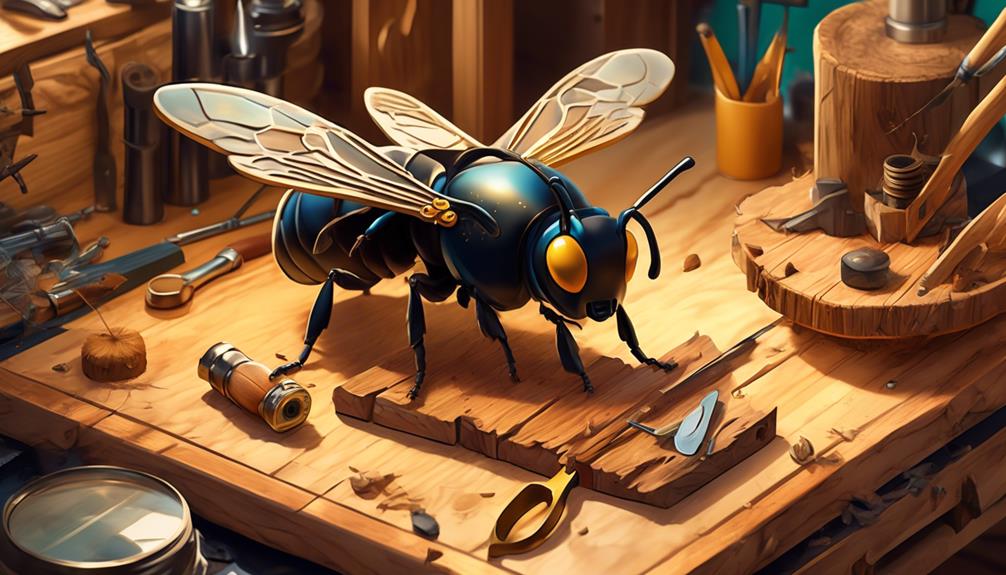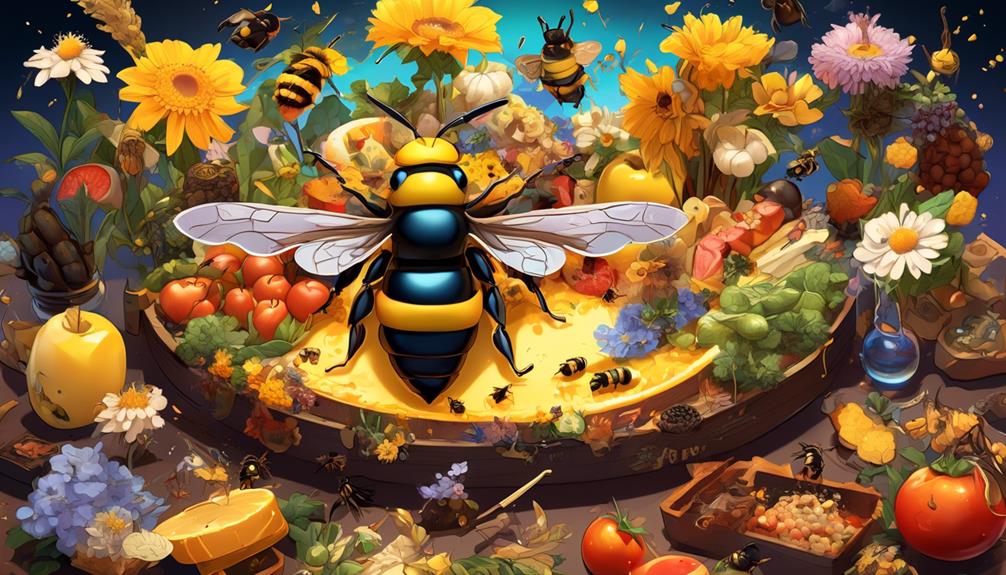An intriguing exploration into the surprising weight of a carpenter bee, and how it influences their fascinating flight-filled lifestyle.

How Much Does a Carpenter Bee Weigh
Imagine holding a feather in your hand, it's light, almost unnoticeable, isn't it? Now think of a carpenter bee. It's an insect, yes, but how much does it really weigh? You might think it's insignificant, but in the grand scheme of things, every ounce counts, especially when you're a creature that spends its life in flight.
The weight of a carpenter bee can vary due to factors such as species, environment, diet, and lifecycle stages. So, let's embark on this journey to uncover the intriguing details of the seemingly insignificant but indeed pivotal weight of the carpenter bee. Who knows what fascinating insights we'll stumble upon?
Key Takeaways
- Carpenter bees typically weigh about 0.7 grams and have a length ranging from 12 to 25 millimeters.
- The weight of carpenter bees can be influenced by factors such as diet, seasonal variations, overall health, and mite infestation.
- Male carpenter bees are generally lighter than females due to their smaller size and less fat storage.
- Weight can impact bee behavior, including energy expenditure for flight, mating practices, survival in harsh conditions, susceptibility to predation and disease, and overall bee health.
Understanding Carpenter Bee Basics

To fully grasp the intricacies of the Carpenter Bee, it's crucial to first understand their basic characteristics, which include their typical weight, physical attributes, and nesting behaviors. Weighing in at about 0.7 grams, they're robust, sizeable insects. Their bodies are black, usually covered in yellow or white hair, with a length ranging from 12 to 25 millimeters.
A key identifier of a Carpenter Bee is their shiny, hairless abdomen, contrasting their hairy thorax. In terms of nesting, they're unique in the insect world. You'll find them drilling into wood to create tunnel-like nests, hence their name. The female does the drilling, and while the process is slow, she's methodical and precise, ensuring the nest is perfect for her offspring.
Understanding these basic characteristics is key in recognizing Carpenter Bees. Their weight, physical attributes, and nesting behaviors distinguish them from other insects. By understanding these intricacies, you'll be equipped to identify and understand the Carpenter Bee better.
As you delve deeper into the world of these amazing creatures, remember, each attribute plays a significant role in their survival and propagation.
Factors Influencing Bee Weight

Various factors can significantly influence a Carpenter Bee's weight. These factors include its diet, the season, and its overall health. Carpenter Bees, like many insects, are greatly affected by their nutritional intake. A diet rich in pollen and nectar, their primary food sources, allows them to maintain a healthy weight. However, if they're unable to access these resources, their weight may decline.
The season also plays a critical role in a Carpenter Bee's weight. During spring and summer, when food is abundant, Carpenter Bees tend to weigh more. Conversely, in the colder months, when food sources are scarce, they may lose weight.
Lastly, a bee's overall health influences its weight. Just like in other organisms, diseases and parasites can cause weight loss. For example, a mite infestation can lead to malnutrition, resulting in a significant weight drop. On the other hand, a healthy Carpenter Bee that's free of disease and parasites will likely maintain a stable weight.
Comparing Carpenter Bee Weights

Given the factors that influence a Carpenter Bee's weight, it's interesting to draw comparisons between the weights of different Carpenter Bees in varying conditions. Although size, diet, and environment all play significant roles, it's worth noting that Carpenter Bees typically weigh between 0.00025 to 0.00075 ounces.
There's a fascinating difference in weight when comparing male and female Carpenter Bees. Males tend to be lighter due to their smaller size and less fat storage. Conversely, females, being larger and having more reserves for egg-laying, are typically heavier.
To help you visualize this, here's a markdown table that compares the average weights of Carpenter Bees based on gender and geographical location:
Gender/Location | Average weight (oz) |
|---|---|
Male/Urban | 0.0003 |
Female/Urban | 0.0006 |
Male/Rural | 0.00025 |
Female/Rural | 0.00075 |
This comparison shows that location also affects a bee's weight. Urban bees often have access to more diverse food resources, resulting in increased weight. However, rural bees, exposed to fewer pollutants, may live longer and thus have more time to accumulate weight. This is yet another intriguing aspect of the complex world of Carpenter Bees.
Measuring a Carpenter Bee's Mass

In the pursuit of understanding the intricacies of Carpenter Bee's biology, you'll find it's crucial to accurately measure their mass, a task that may appear daunting due to their minuscule size. However, with the right tools and approach, it's entirely feasible.
You'll need a precision balance, ideally one that measures up to 0.001 grams. These bees typically weigh between 0.07 to 0.1 grams, so precision is essential.
Begin by capturing the bee gently in a small, ventilated container. It's crucial not to harm the bee during this process as injury can affect the weight measurement.
Next, zero out your precision balance with the container on it. This allows you to isolate the bee's weight from the container's. Once your balance is calibrated, carefully place the bee inside and record the weight.
It's recommended to repeat the process a few times to ensure accuracy.
Impact of Weight on Bee Behavior

Now that you've got an accurate measure of the carpenter bee's weight, let's explore how this weight can influence their behavior.
The bee's weight, in fact, has multiple impacts on its behavior and overall lifestyle.
A primary way weight impacts these bees is through their flight abilities. Heavier bees require more energy to fly and thus, they must consume more food. This potentially limits their range and affects their pollination patterns.
Also, the weight of a bee can influence its mating practices. In general, lighter male bees can outmaneuver and outcompete heavier males, leading to a genetic skew towards lighter males over time.
Furthermore, the weight of a bee is directly linked to its health. Bees that are underweight might lack the energy reserves to survive harsh conditions or periods of food scarcity. On the other hand, overweight bees may be more susceptible to predation and disease due to decreased mobility.
Conclusion
In conclusion, a carpenter bee's weight, influenced by factors such as age, sex, and nutrition, averages around 0.00025 ounces. This weight is significant and varies among species, impacting behavior such as flight. Reliable measurement of their mass requires precision.
However, it's clear that understanding the weight of these bees sheds light on their intriguing biology, lifestyle, and role in the ecosystem. Keep observing and learning about these fascinating creatures!



